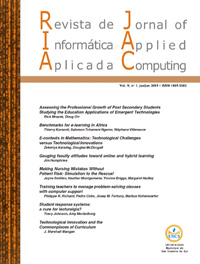Making Nursing Mistakes Without Patient Risk: Simulation to the Rescue!
DOI:
https://doi.org/10.13037/ria.vol5n1.374Keywords:
Simulation, Learning Systems, NursingAbstract
Perils to patient safety, the bulk of the responsible errors involving medications, account for unfathomable costs within our healthcare system (IOM, 1999; CPSI, 2003). Patient safety has been and continues to be in jeopardy and is of paramount importance in the Canadian healthcare system. Patient safety initiatives have included examination of current educational strategies and new initiatives to aid in reducing these costly errors as a result of adverse events that were preventable (CPSI, 2003). High-fidelity patient simulation can provide promising patient safety solutions to assist in the teaching and learning environments within nursing educational programs. Faculty teaching and learning initiatives, utilizing the high-fidelity human patient computer-controlled simulation (HHPCS) as an adjunct technology in the Bodnar Simulation Suites of the new Robbins Health Learning Centre in Edmonton, Alberta, have included examining the capabilities to thwart the reality of making mistakes in patient safety, including medication administration errors, without compromising the safety, even potentially the lives, of real patients. Development of new patient safety modules utilizing the HHPCS provides further evidence of its importance as an adjunct technology within the context of nursing educational programs. This paper is presented to promote further discourse on the potential of highfidelity simulation technology as a vital tool in the future of nursing education. Designing and establishing effective educational and professional development programs in simulation are proposed to be integral to building a safer healthcare system. Further research is recommended to authenticate the role of high -fidelity human simulation technologies in the pursuit of better learning outcomes and inevitably improved patient safety outcomes.Downloads
References
BAKER, R., NORTON, P. Making patients safer! Reducing error in Canadian healthcare. Health C Pap, 2 (1): 10-30, 2001.
BAKER, R., NORTON, P., FLINTOFT, V. The Canadian adverse events study: The incidence of adverse events among hospital patients in Canada. Canadian Medical Association Journal, 170(11), 1678-1686, 2004.
BREMNER, M. N., ADUDDELL, K., BENNETT, D. N., & VANGEEST, J. B. (2006). The use of human patient simulators: Best practice with novice nursing students. Nurse Educator, 31(4), 170-174.
COMER, S. K. Patient care simulations: Role playing to enhance clinical understanding. Nursing Education Perspectives, 26(6), 357-361, 2005.
FEINGOLD, C. D., CALALUCE, M., & KALLEN, M.A. Computerized patient model and simulated clinical experiences: Evaluation with baccalaureate nursing students. Journal of Nursing Education, 43(4), 156-163, 2004.
GRANTCHAROV, T. P., KRISTIANSEN, V. B., BENDIX, J., BARDRAM, L., ROSENBERG, J , & FUNCH-JENSEN, P. Randomized clinical trial of virtual reality simulation for laparoscopic skills training. British Journal of Surgery, 91 (2), 146-150, 2004.
HAIG, K., SUTTON, S., WHITTINGTON, J. SBAR: A shared mental model for improving communication between clinicians. Journal on Quality and Patient Safety, 32 (3), 167-171, 2006.
HASSEN, P., HOFFMAN, C., GEBRAN, J., LEONARD, P., DYCK, J. The Canadian patient safety institute: Building a safer system and stronger culture of safety. BC Medical Journal 48(7), 334-338, 2006.
INSTITUTE OF MEDICINE. Crossing the Quality Chasm: A New Health System for the 21st Century. Washington: National Academy Press, 2001. Available at:http://www.nap.educatalog/10027.html
INSTITUTE OF MEDICINE. To Err is Human: Building a Safer Health System. Washington:National Academy Press, 1999. Available at:http://www.nap.edu/to_err_is_human (accessed December 9, 2007).
JEFFRIES, PL, WOOLF, S., & LINDE, B. Technology-based vs. traditional instruction. A comparison of two methods for teaching the skill of performing 12-lead ECG. Nursing Education Perspectives, 24(2), 70-74, 2003.
LASATER, K. L. High-fidelity simulation and the development of clinical judgment: Student's experiences. Journal of Nursing Education 46(6), 269-276, 2007.
McCAUSLAND, L. L., CURRAN, C. C. & CATALDI, P. Use of a human simulator for undergraduate nurse education. International Journal of Nursing Education Scholarship, 1(1), 1-17, 2004.
PATOW, C. A. Advancing medical education and patient safety through simulation learning. Patient Safety & Quality Healthcare, March/April, 2005.
TREADWELL, I., GROBLER, S. Students' perceptions on skills training in simulation. Medical Education, 23(5), 476-482, 2001.
WELLER, J. M. Simulation in undergraduate medical education: Bridging the gap between theory and practice. Medical Education, 38(1), 32-38, 2004.
WILFORD, A., & DOYLE, T. Integrating simulation training into nursing curriculum. British Journal of Nursing, 15(11), 604-607, 2006.
WORLD HEALTH ORGANIZATION. Quality of Care: Patient Safety, 2002.
Downloads
Published
Issue
Section
License
Copyright (c) 2010 Jayne Smitten, Heather Montgomerie, Yvonne Briggs, Margaret Hadley

This work is licensed under a Creative Commons Attribution-NonCommercial-ShareAlike 4.0 International License.
Os autores que publicam trabalhos na RIA estão de acordo com os seguintes termos:
- Autores mantêm seus direitos autorais e concedem à RIA o direito à primeira publicação. Admite-se o compartilhamento do referido trabalho, desde que seja reconhecida sua autoria e publicação inicial nesta revista.
- Autores podem fechar contratos adicionais separadamente, para distribuição não exclusiva da versão do trabalho publicado na RIA, com reconhecimento de sua autoria e publicação inicial nesta revista.
- Autores podem publicar e distribuir seu trabalho online, antes ou durante o processo editorial.


